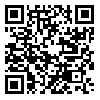BibTeX | RIS | EndNote | Medlars | ProCite | Reference Manager | RefWorks
Send citation to:
URL: http://salmandj.uswr.ac.ir/article-1-43-en.html
Objectives: Ageing and its consequences at the onset of the third millennium is becoming one of the major population-related issues in all countries.
Methods & Materials: At present, Iran is undergoing a population transformation from a young age structure to an old age one. Although at the time being the elderly population (60 years and over) is rather small proportion of total population, but given increasing the elderly population growth compared to that of total population during the coming decades, it is necessary to make careful plans to deal with the problems of this age group. This study aims to assess the trend and changes in sex ratio, average annual growth rate, ageing index and dependency ratio of the elderly population by documentary method during the period 1956 through 2006 using Iran's Population and housing census data that collected by Statistical Centre of Iran.
Results: According to our findings, the estimates of some basic demographic indices such as the proportion, sex ratio, average annual growth rate, ageing index and dependency ratio for the Iranian elderly population at 2006 were 7.3%, 108, 2.5%, 29 and 43.4%, respectively. Considering the rapid decline in fertility during the last two decades, it is anticipated that ageing process will accelerate. This process is documented by observed trend of fertility and mortality rate and their possible changes in the future.
Conclusion: Considering the facts, figures and findings of this study Iran is going to experience an increasing proportion of elder population by the beginning of the next solar century.
Received: 2007/06/01 | Accepted: 2007/08/01 | Published: 2007/10/01
| Rights and permissions | |
 |
This work is licensed under a Creative Commons Attribution-NonCommercial 4.0 International License. |





